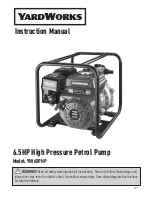
PB3 User Instruction
Page 22 of 39
and the pump size. It is impractical to install a suction strainer to remove particulate of this size. Such particles
will normally pass through the pump without causing damage, provided the concentrations are minor.
The possibility exists that, on shutdown of the pump, such particles can become trapped in the close running
clearances during coast down, causing binding.
Caution
Excessive force used to try to free a bound rotor may cause damage beyond minor
cleanup and repair of rotor parts.
Generally, a pump should not be installed without start-up strainer protection. The suction piping should be
thoroughly flushed before installing the suction strainer and connecting the suction piping to the pump. The
strainer should be installed in the inlet piping near the pump, making certain that it is located where it may be
readily serviced (cleaned). Be sure, however, that the installed strainer will not distort the flow to the pump
suction nozzle.
Do not install the strainer directly on the pump suction nozzle. For a cone-type strainer, the downstream end of
the cone should be no closer than four (4) pipe diameters from the pump suction nozzle. Basket-type strainers
typically introduce greater flow disturbances and should be installed at least six (6) pipe diameters from the
pump suction nozzle.
The PUMPIRAN standard for suction strainers consists of conical-shaped steel plate with 1/8 in. perforations
see the below picture. The open area of the strainer should be a minimum of three times the area of the pump
suction.
At all times when using suction strainers, it is critical that the pressure drop across the strainer be constantly
monitored to ensure that the pump suction pressure does not fall below that required to prevent pump
cavitation. Pressure (or vacuum) gauges should be installed on both sides of the strainer so that the pressure
drop across the strainer can be monitored. During start-up of the system, the gauges should be monitored
continuously. Consult the plant engineer or system designer for the allowable pressure differential across the
strainer prior to operating the pump. Pressure differential across the strainer and/or screen is typically no more
than 2 – 3 psig. An increase in the differential pressure between the two gauges indicates that the strainer or
screen is becoming clogged with dirt and scale. Before the pressure drop becomes so severe that cavitation
occurs, the pump should be shut down and the strainer cleaned. Alarm settings to protect the pump from
damaging cavitation and loss of suction need to be supplied by the plant engineer or system designer prior to
operating the pump. Typical alarm settings to protect the pump from damaging cavitation and loss of suction
would be 5 psig differential pressures across the strainer (screen). The suction piping should be arranged such
that the ultimate strainer configuration (location) allows ready access for cleaning.
















































